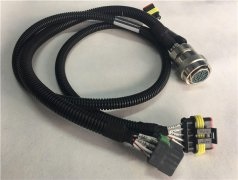Medical wiring harness manufacturers analyze the difference between the internal antenna and the external antenna. The antenna converts high-frequency electromagnetic energy in transmission into electromagnetic waves in free space, or vice versa, converts electromagnetic waves in free space into high-frequency electromagnetic energy in transmission lines.
In the wireless transmission system, the design of the antenna is particularly important, and the quality of the antenna directly affects the quality of communication.
With the development and evolution of wireless devices, the domineering exposed external antenna has gradually turned to the implicit and restrained internal antenna. However, customers may ask whether the signal performance of wireless products with built-in antennas will be greatly reduced, and the performance is not as good as that of external antennas?

After several tests and statistics in the equipment manufacturer’s laboratory, we found that in the same environment, the wireless products equipped with built-in antennas and products equipped with external antennas have no significant difference in wireless signal strength, and the difference range is only 1- Between 3%. And the more barriers and the more complex the environment, the less obvious the gap. Therefore, we can conclude that the built-in and external antennas have little effect on the coverage of the wireless router.
External antennas are mainly the psychological habits of most consumers. It is believed that the more antennas, the better the signal, and the stronger the antenna, the stronger the signal. The use of external antennas has virtually increased the number of faulty nodes in network engineering, and the construction quality of the incomplete antennas of the engineers is also a potential hazard. In the case of high requirements on the shape and size of the node, the external antenna needs to occupy a large volume in space, which may not be suitable for applications in some occasions. At the same time, the external antenna reduces the user's acceptability in appearance, and has a certain impact on the market productization of related achievements.

The design of the built-in antenna not only faces size limitations, but more importantly, performance challenges. When the antenna is placed inside the device, there are problems in the mechanical design, such as the connection method between the antenna and the device shell, the contact method between the antenna feed point and the PCB board, and the design of the built-in antenna itself.
Kunshan Ruichengda Electronics Co., Ltd., as a professional international wireless equipment manufacturer, has designed a series of high-gain wireless products with built-in antennas by virtue of strong technical advantages and engineering accumulation. The built-in antenna is installed inside the device, has mechanical rigidity, is not easy to be damaged, and has excellent mechanical performance. There is no need to consider the uneven quality of the antenna to reduce hidden network hazards. The equipment antenna is highly integrated to ensure the perfect operation of the equipment.

External antennas have been replaced by built-in antennas, and most concerns about the performance of the built-in antennas now disappear. As far as the key electrical parameter of antenna efficiency is concerned, a well-designed internal antenna can provide the same performance as an external antenna.
Compared with external antennas, internal antennas have the same performance, better appearance characteristics and more robustness. Therefore, the transition from external to internal antennas has become an irreversible trend. Manufacturers of medical harness processing believe that both have their own advantages and disadvantages, depending on how you choose.
